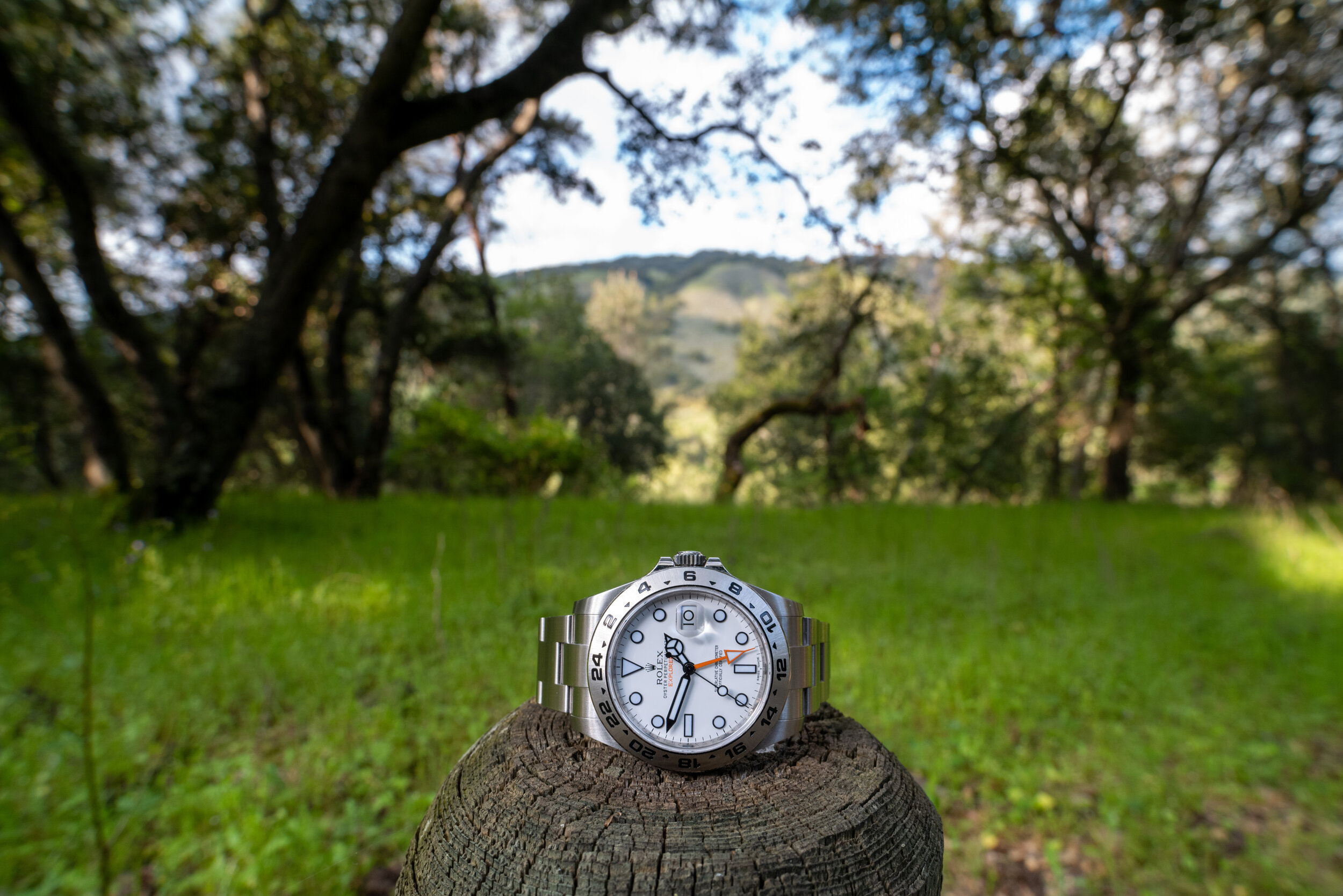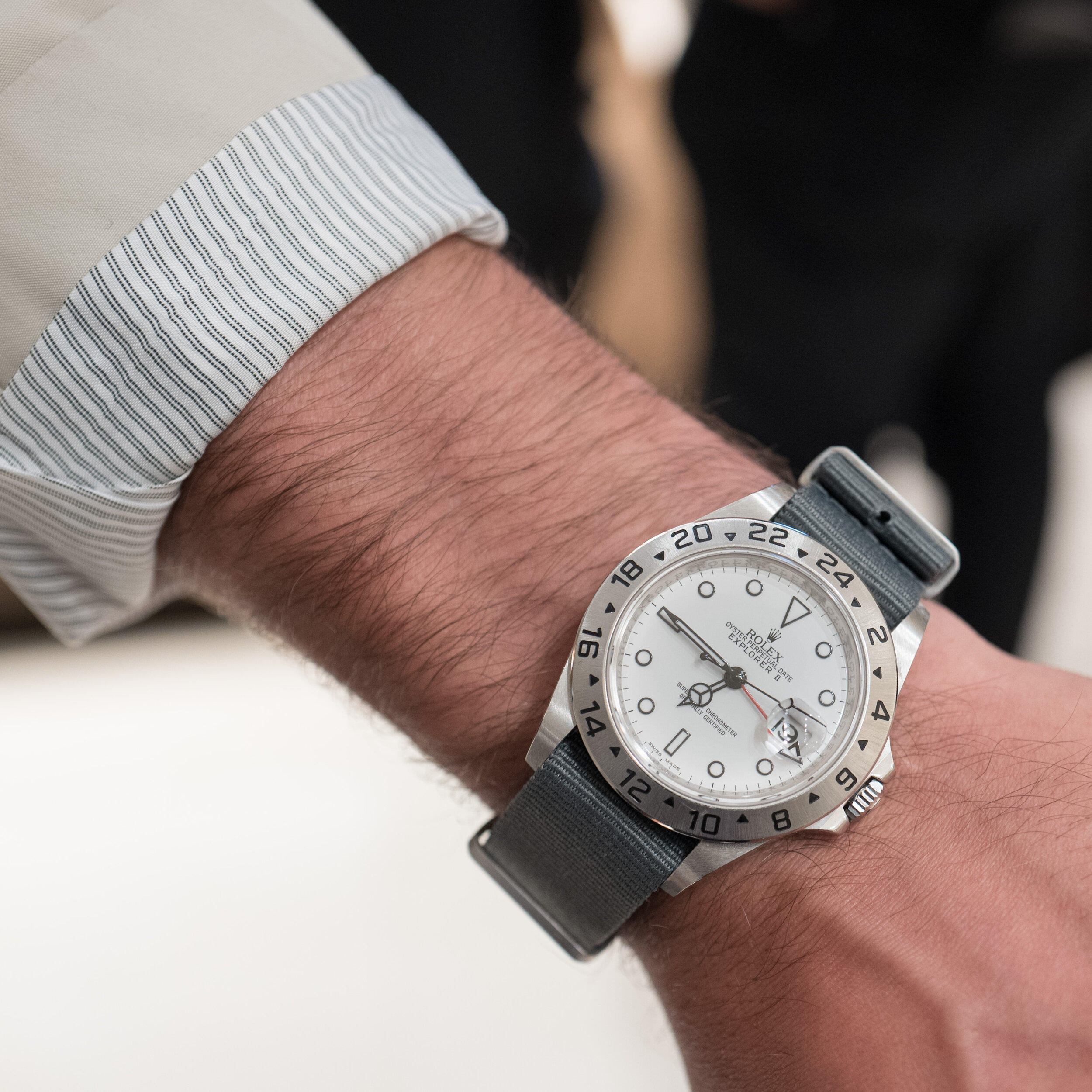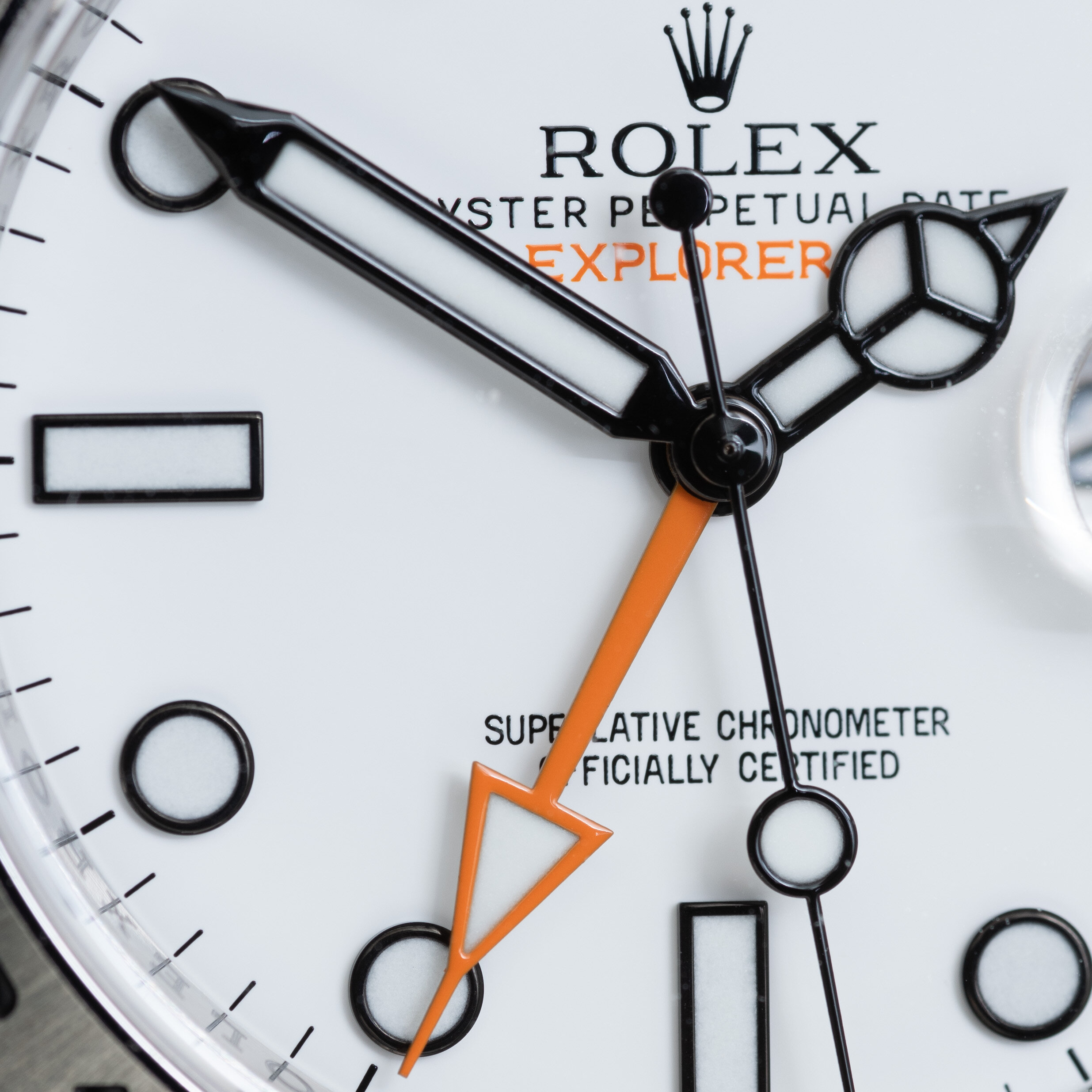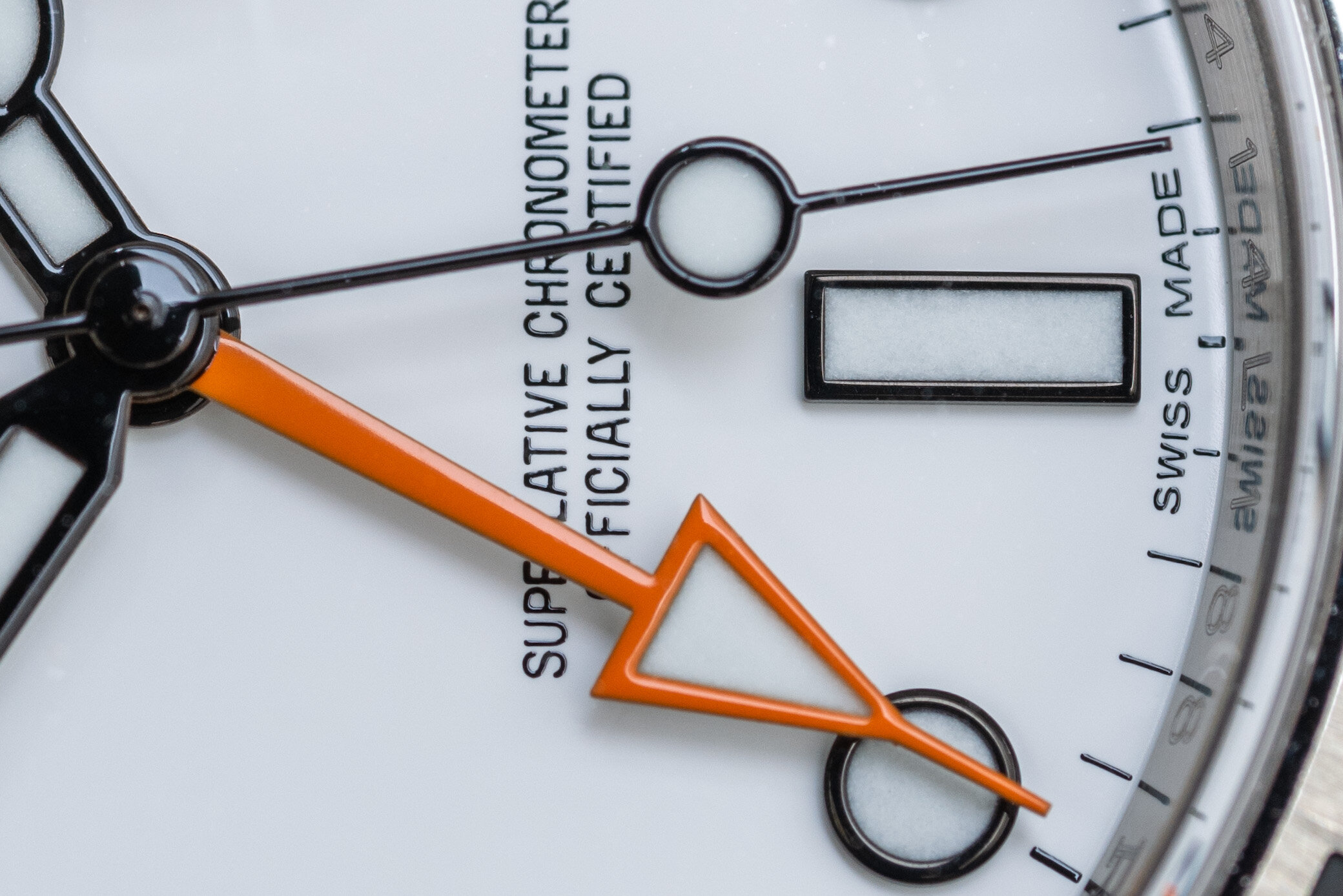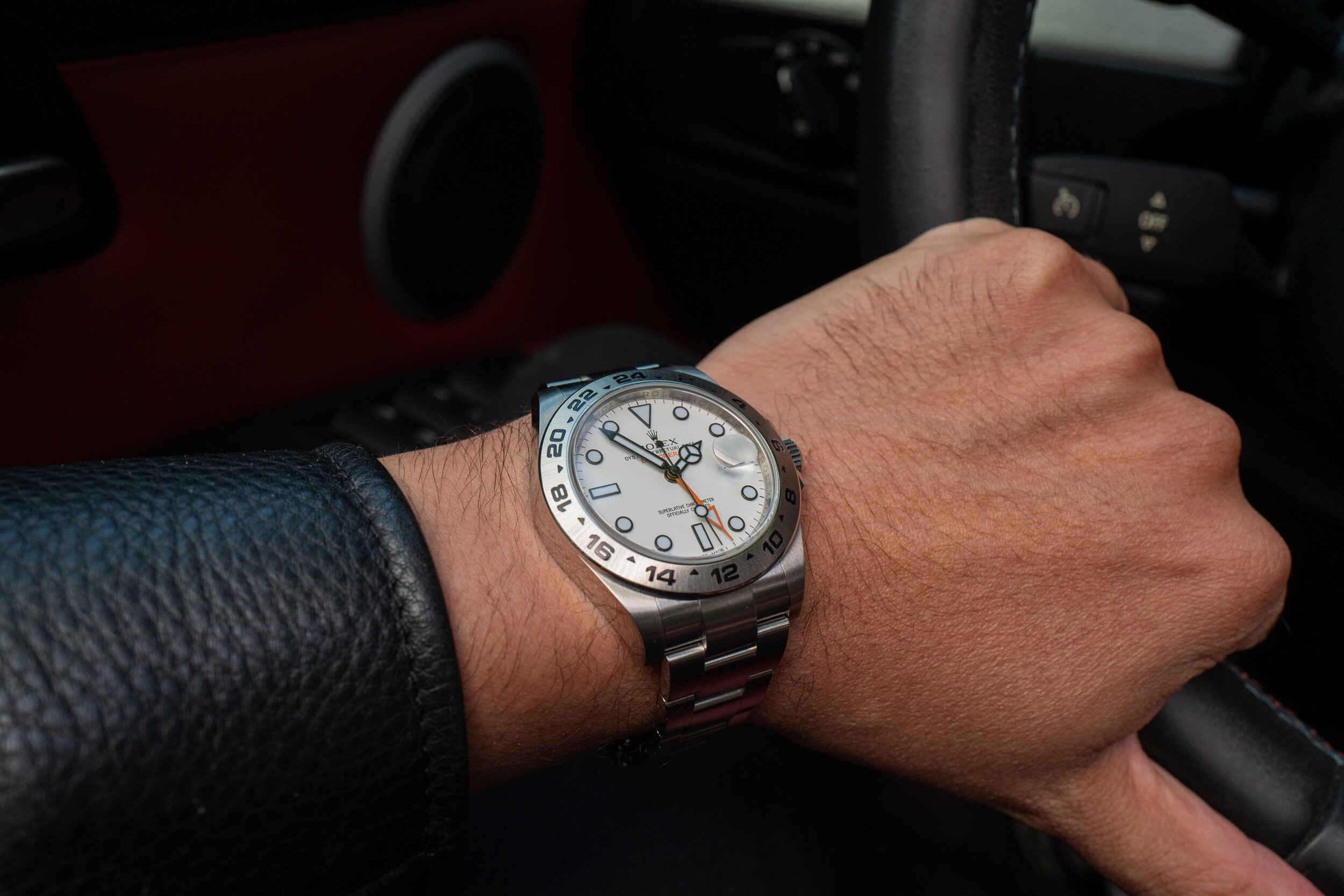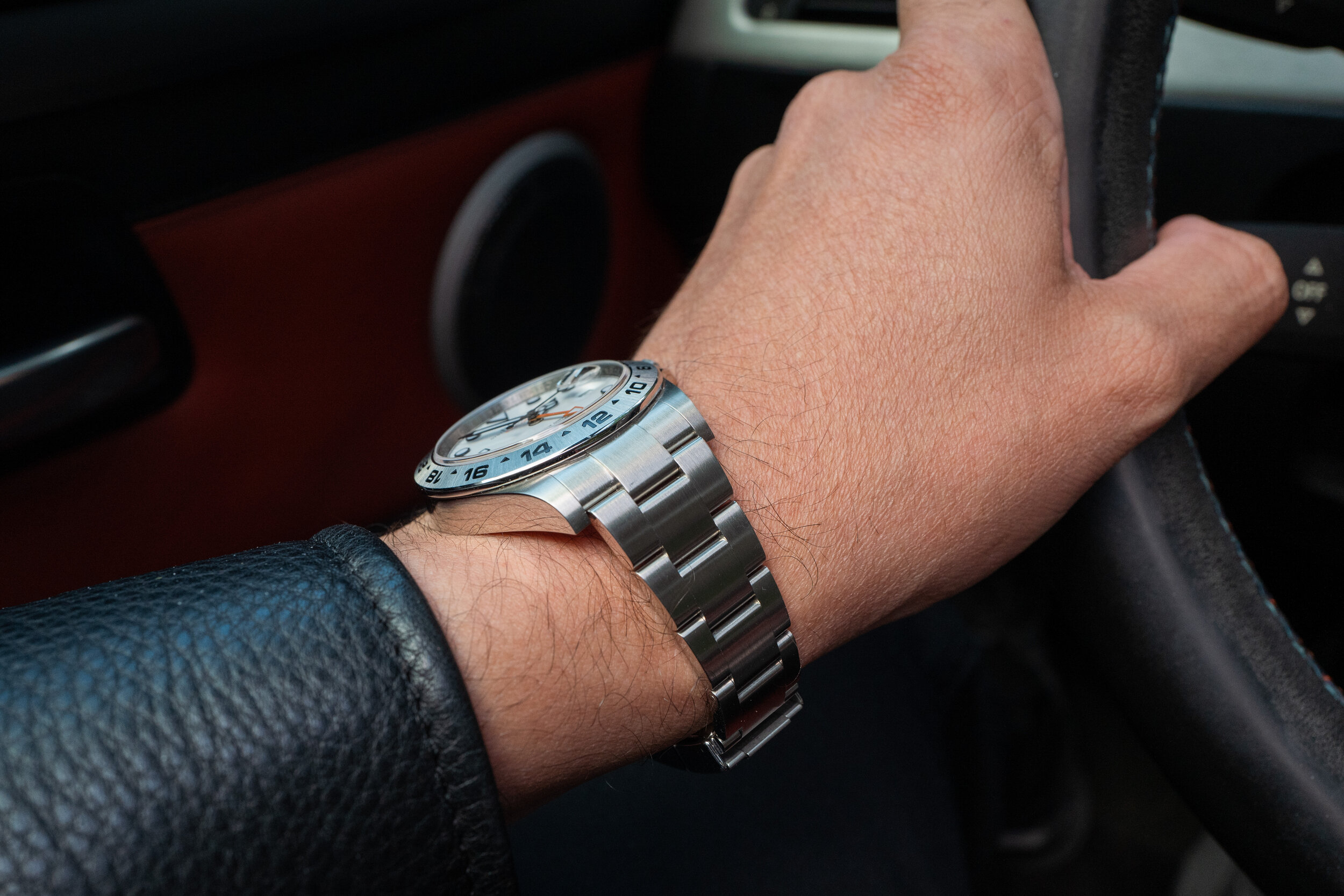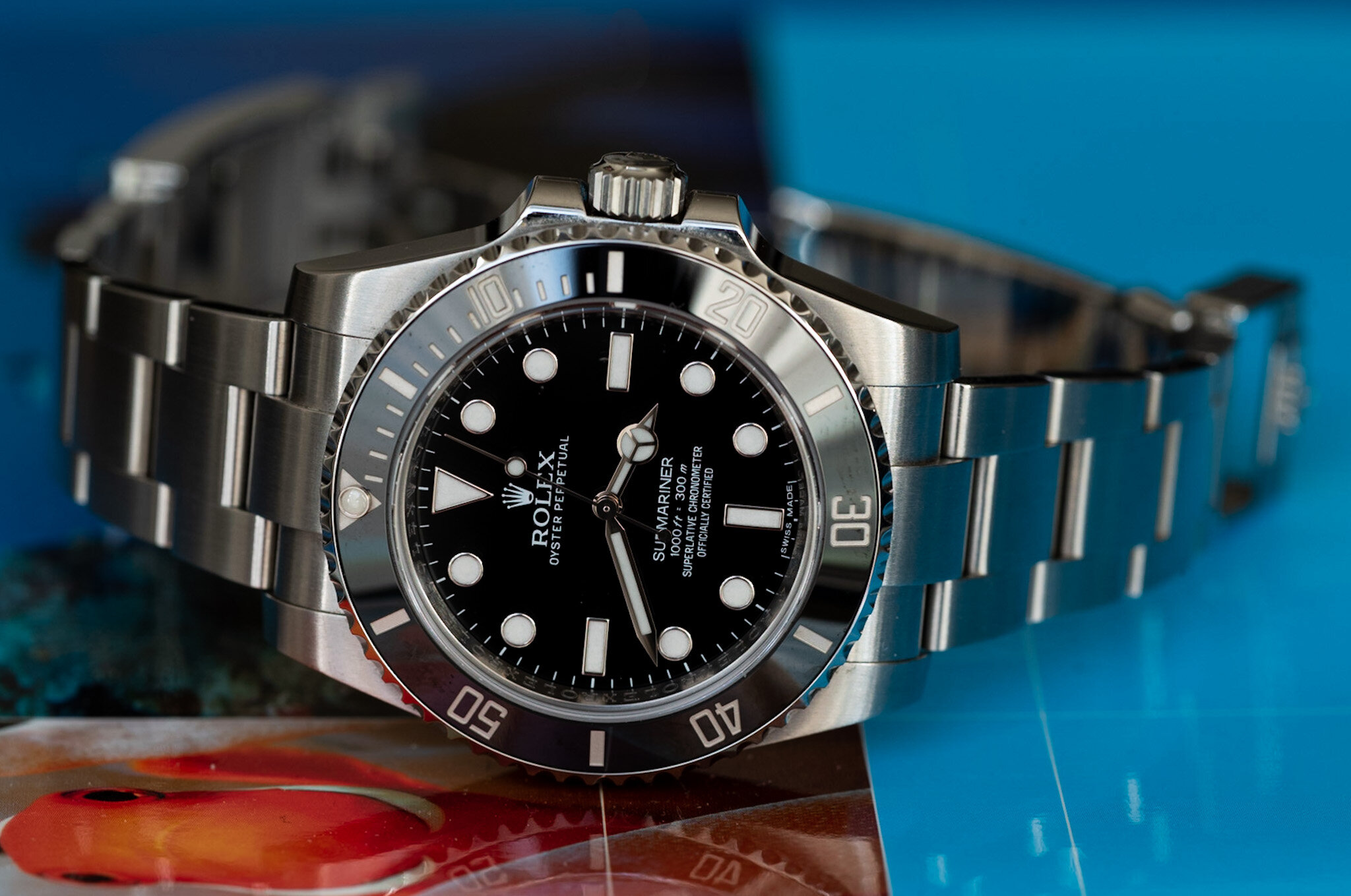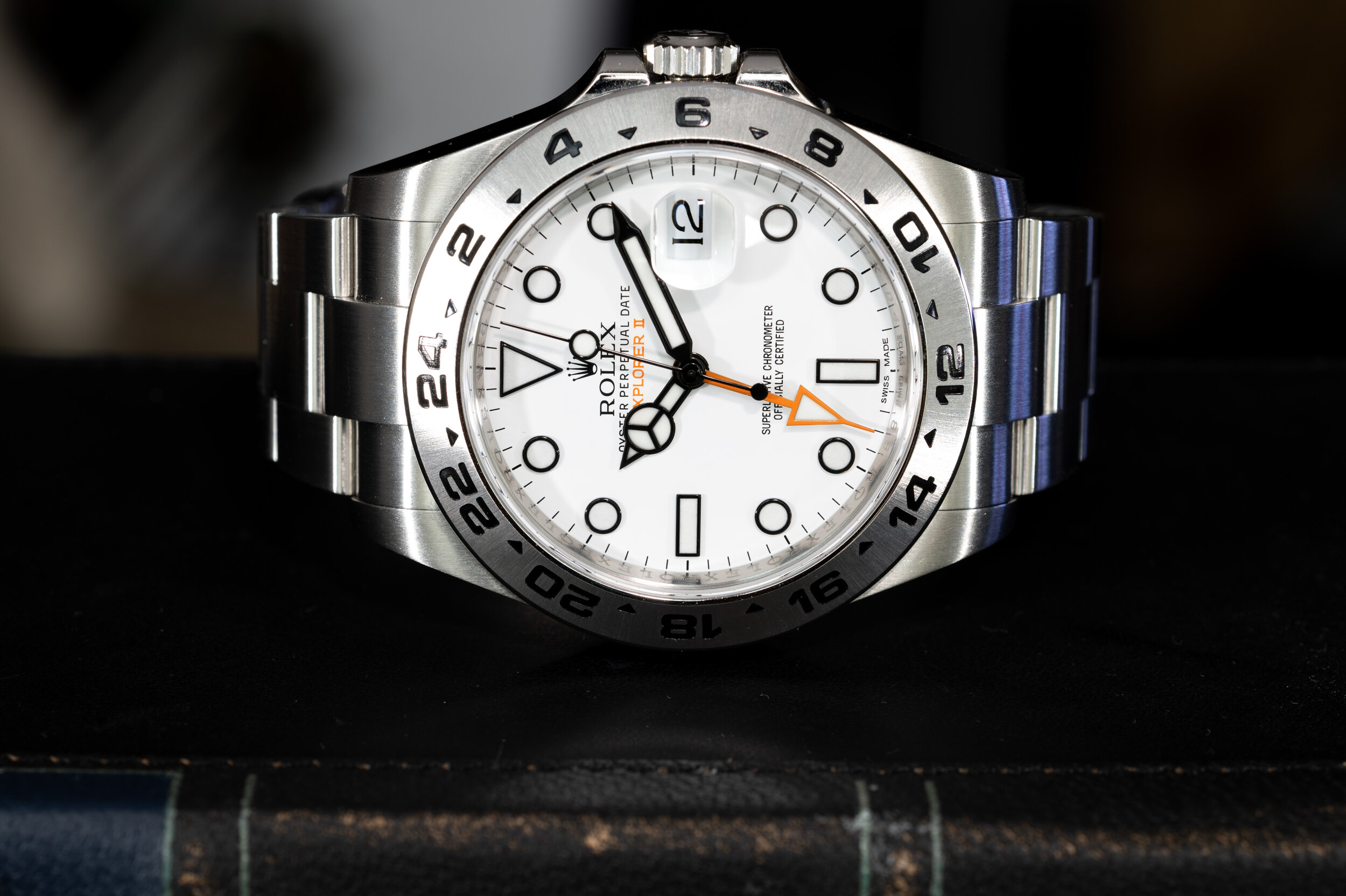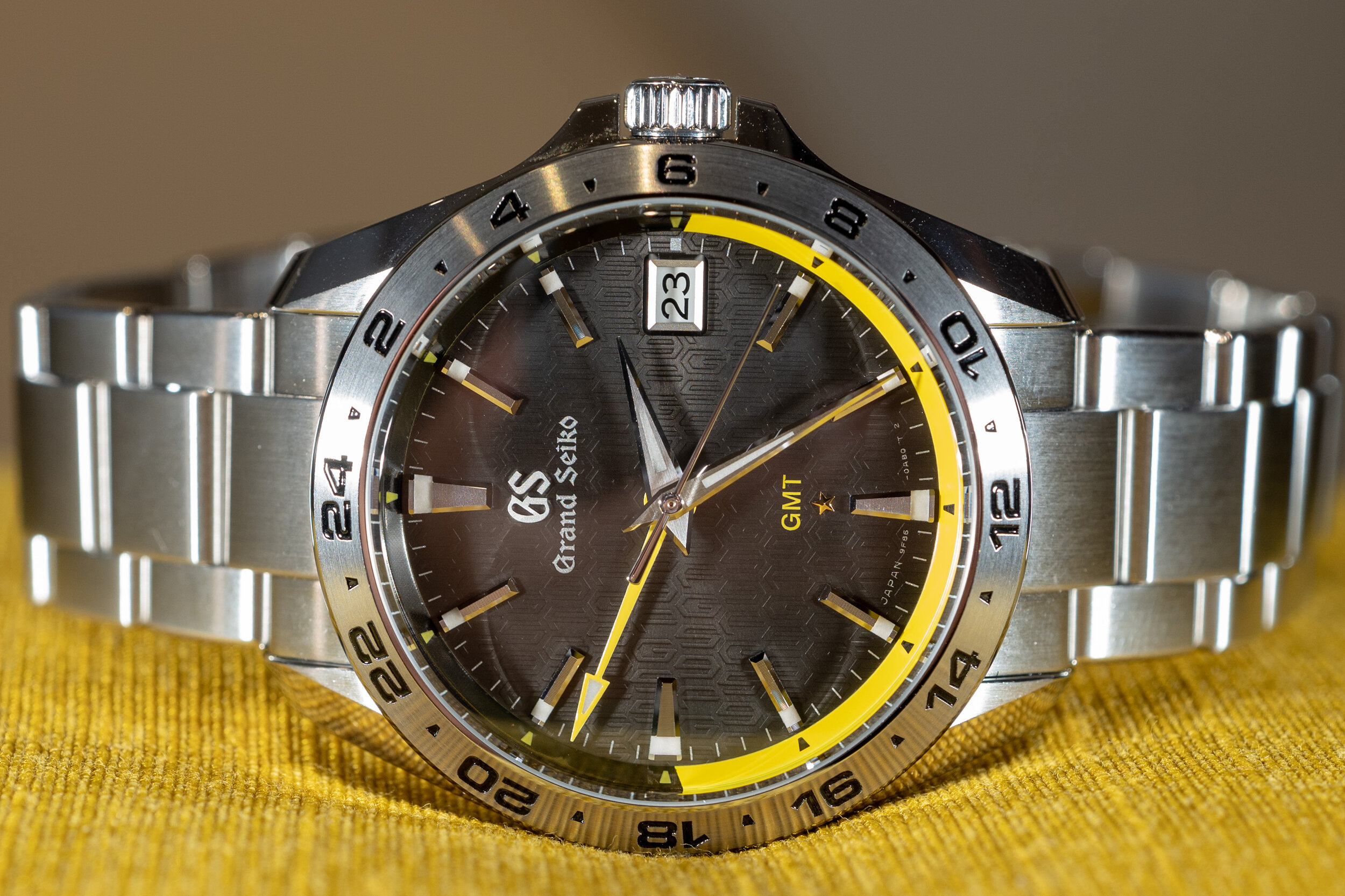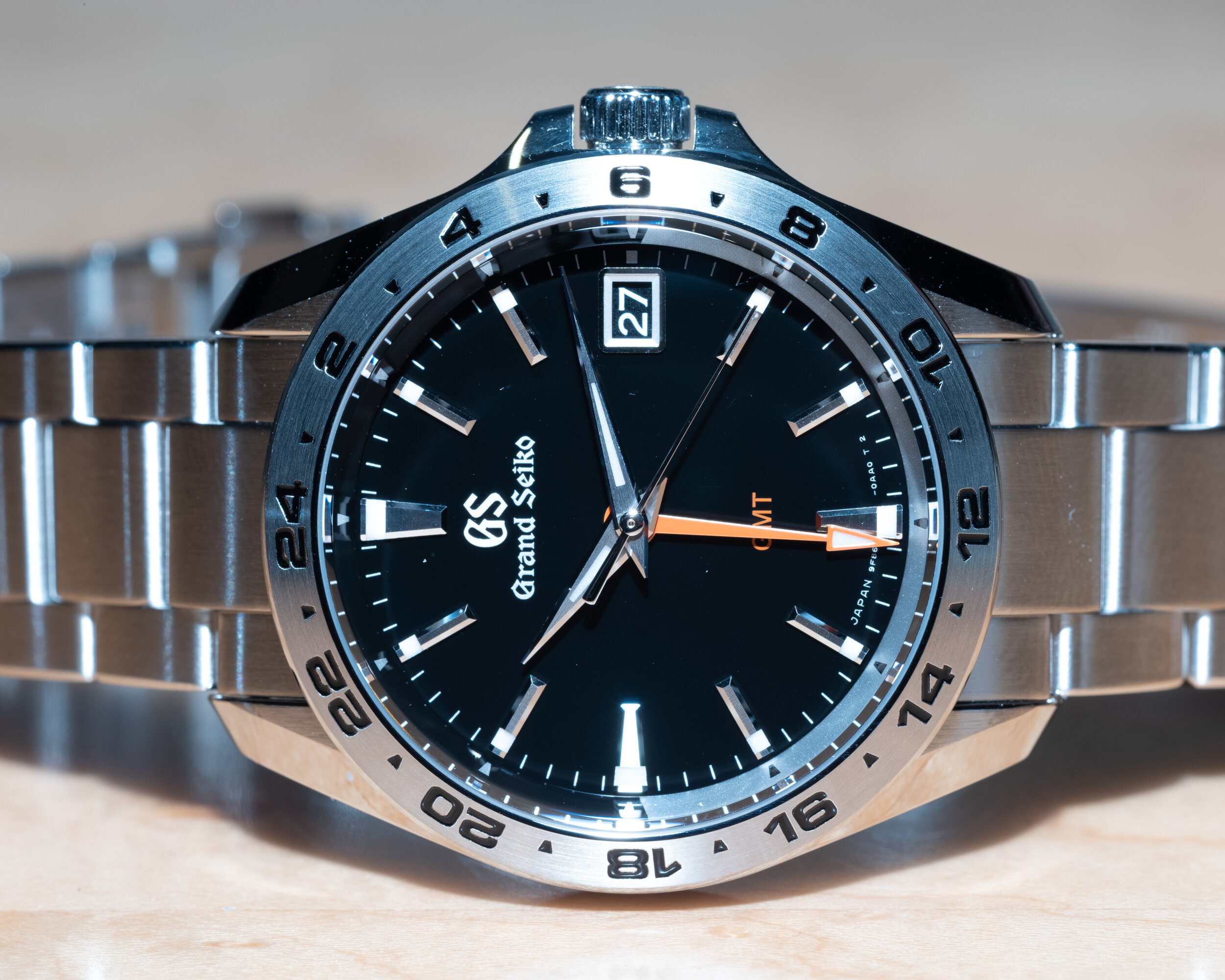Thoughts on my Rolex Explorer II “Polar” 216570
Background
When novice watch enthusiasts first get enamored by the watch collecting bug, they search and search for the first best watch to acquire, or the second one, if they already have a nice watch. The following models are often suggested by watch connoisseurs: Omega’s Speedmaster moon watch, Grand Seiko Spring Drive “snowflake”, and the Rolex Explorer II.
At least for me these are the watches that were most often recommended in my own searches; and during the many discussions I had with seasoned collectors as I started contemplating acquiring another good watch, almost 10 years ago. I want to discuss this whole notion of second good watch as I expose my thoughts on my own Rolex Explorer II reference 216570 “polar” edition which was the watch I finally acquired over six years ago.
Introduction
I acquired this watch as a birthday present to myself in 2014. While initially it saw much wrist time, today, I rarely wear it. And this is not because I dislike or regret this acquisition, it actually has a spot in my small permanent watch collection. However, my views have evolved and today, it is a watch that I think missed the mark and I believe should not necessarily be a top recommendation for early collectors. Let me explain my rational, but let’s first explore what makes the Explorer II unique, list some of its quirks, as well as the many positive things it has going for it.
Brief History
Rolex has been involved in exploration since the 1930s. They famously produced the watches worn on the wrists of the first explorers to climb the world’s tallest peaks — particularly the highest: Everest, in 1953 by Sir Edmund Hillary and Tenzing Norgay. And while you might think of this as being a stunt today, in these days, having a watch that could tell you the accurate time during your ascent, so you can plan your way back, was really a matter of life and death.
And Rolex wanted back then, as they do now, that their watches could be such timing instruments. The Rolex Explorer that Sir Hillary wore still resembles the classic Explorer watch that Rolex sells today in a modern variation as reference 214270. And that watch and the series of events it participated in, actually led to the creation of the Rolex professional family of watches that nowadays includes the Submariner and Daytona to name two more classic sports Rolex professional models.
In 1971, Rolex introduced the first Rolex Explorer II. It addressed a major problem with the original Explorer (reference 6150), in that it offered a way for explorers to tell between day and night. While it’s easy to tell the distinction if you can gaze outside and look for the sun, the reality is that cave explorers and in some regions of the earth (e.g., the poles where the sun might not set) it can be hard to know day from night. The original Explorer II had various design changes, including most importantly a 24 hours marked bezel and a third arrow hand with a distinctive orange color.
Initially, the Explorer II watch (reference 1655) distinctive orange hand could only tell you the same time as the hours and minutes hands (except pointing to the 24 hours markers), so it was not a true GMT watch as in the Rolex GMT Master. But with reference 16550 Rolex refined the watch, including using the more readable mercedes hands, a 40 mm case, and an arrow hand similar to the GMT Master II. The updated model also included movement 3085 which allowed the 24 hours hands to be independently set, so becoming a true GMT watch.
Vintage Rolex Explorer II reference 16570
After offering a few updates to the 16550 and then 16570, which included white and black color dials, as well as variations on the luminescent materials used, Rolex released reference 216570 for the 40th anniversary of the Explorer II in 2011. The watch was redesigned with a movement that could indicate two timezones with quick jumping hours, and it also rebooted the orange pointer hand like in the original model. This is the watch I own and review in this post.
Reference 216570 - white dial
The first observable feature of the new Explorer II is that unlike most of the other models in the Rolex sports line up, which are typically 40 mm or less, the Explorer II comes in at 42 mm. It almost feels as if Rolex used it as an experiment, especially when considering this is the second Explorer model in production, the initial classic Explorer model remained at 36 mm and 39 mm and with the iconic 3, 6, 9 dial layout. The Explorer II 216570 on the other hand includes the so-called “maxi dial layout” and a large orange GMT hand that Rolex first used when the first Explorer II had come to market in 1971.
Another unique characteristic of the Explorer II is the non-rotating bezel with 24 hours inscription engraved into the steel bezel. While useful to read the GMT hand at a glance, it’s less functional than the Rolex GMT Master II watch whose rotating bezel make it a breeze to use and set the second timezone. The Explorer II’s GMT function requires you to set it using the crown which means that it will often not indicate any useful information for those that have it on rotation and want to quickly wear the watch at a glimpse.
The most striking part of the Explorer II polar for me is the contrast of the white dial with the black glossy painted indices and hands, as well as the orange hints on the dial with the striking orange GMT hand. All make for a Rolex that is unique, almost comical, and even whimsical. People often say it’s the Rolex you will hardly see in the wild. Well, not so true anymore, as watch enthusiasts have made it a go to watch for early collectors.
Movement
As with every Rolex, the Explorer II not only got an updated design when it was re-issued in 2011, it also got a new movement: reference 3187. Building on recent advancements, this new GMT movement includes all the new features found in many of the Rolex professional watches, including the blue Parachrom hairspring which is highly resistant to temperature changes. There is also the Paraflex shock absorbers to allow the encased watch to be rugged, as you would expect in an explorer’s watch. The power reserve is 48 hours and the movement wounds in both direction.
The movement and resulting encased watch is COSC certified with recent models offering +2/-2 seconds a day! But perhaps what makes this movement useful and highly practical is that the watch is a “true GMT”. What I mean is that when you unscrew the crown and pull it in the first position, you can rotate the crown to move the hour hand in jumps. This allows you to set your local time and with enough turns (forward or backward) you can change the date. Pulling the crown in the second position, you can then change all the hands to set your home time, especially using the orange 24 hour hand.
Case and Dial
At 42 mm wide, the Explorer II had at the time of its release in 2011 the second largest size of any of Rolex steel sports watch. Today Rolex has three other watches that are larger: the DeepSea at 44 mm, the YatchMaster II at also 44 mm, and the recently released SeaDweller 43 mm 50th anniversary. In 2019 Rolex released yet another 42 mm watch in the YatchMaster 42 in white gold.
The case of the Explorer II is large, but it’s somewhat more wearable than the SeaDweller watches due to the smaller lugs. At 50 mm lug-to-lug, on my wrist (6.5 inches) the watch has an impressive presence. And while it’s a large watch, the super legible dial is what really stands out. The reason is simply the high contrast of the “maxi dial” layout which is used in the Explorer II (particularly the white dial version). This happens due to the glossy black paint on the indices as well as the large hands.
It’s very clear when seeing the Explorer II for the first time that there was a special attention to making the dial readable. The large orange hand for the GMT is clear and even more legible than the mercedes hour hand and the rather comically wide minutes hand. The other aspect of the Explorer II that stands out is the 24 hour chapter ring which is embedded in black paint on the steel bezel. The orange pointy hand make reading the 24 hour bezel markers easy.
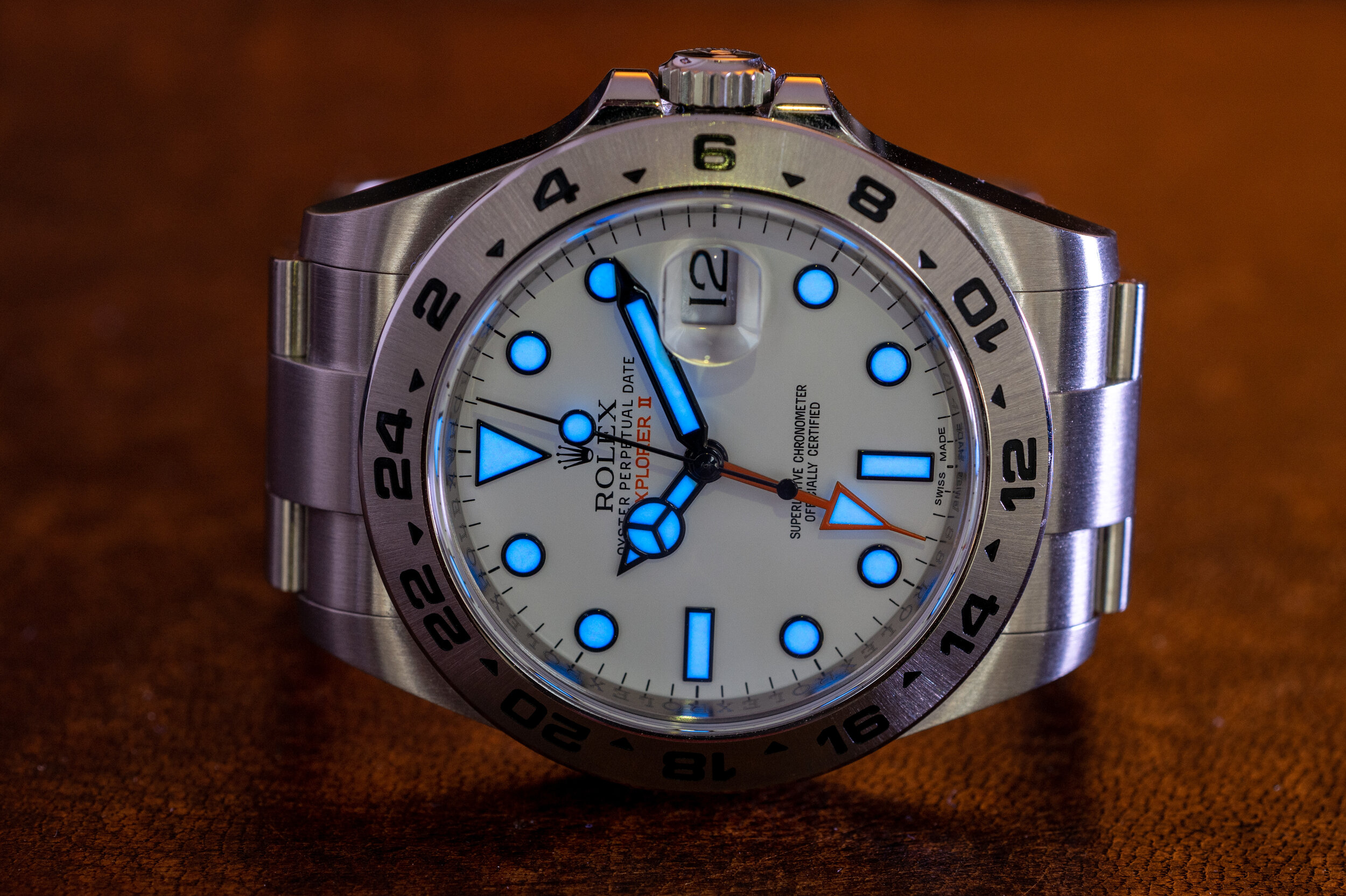
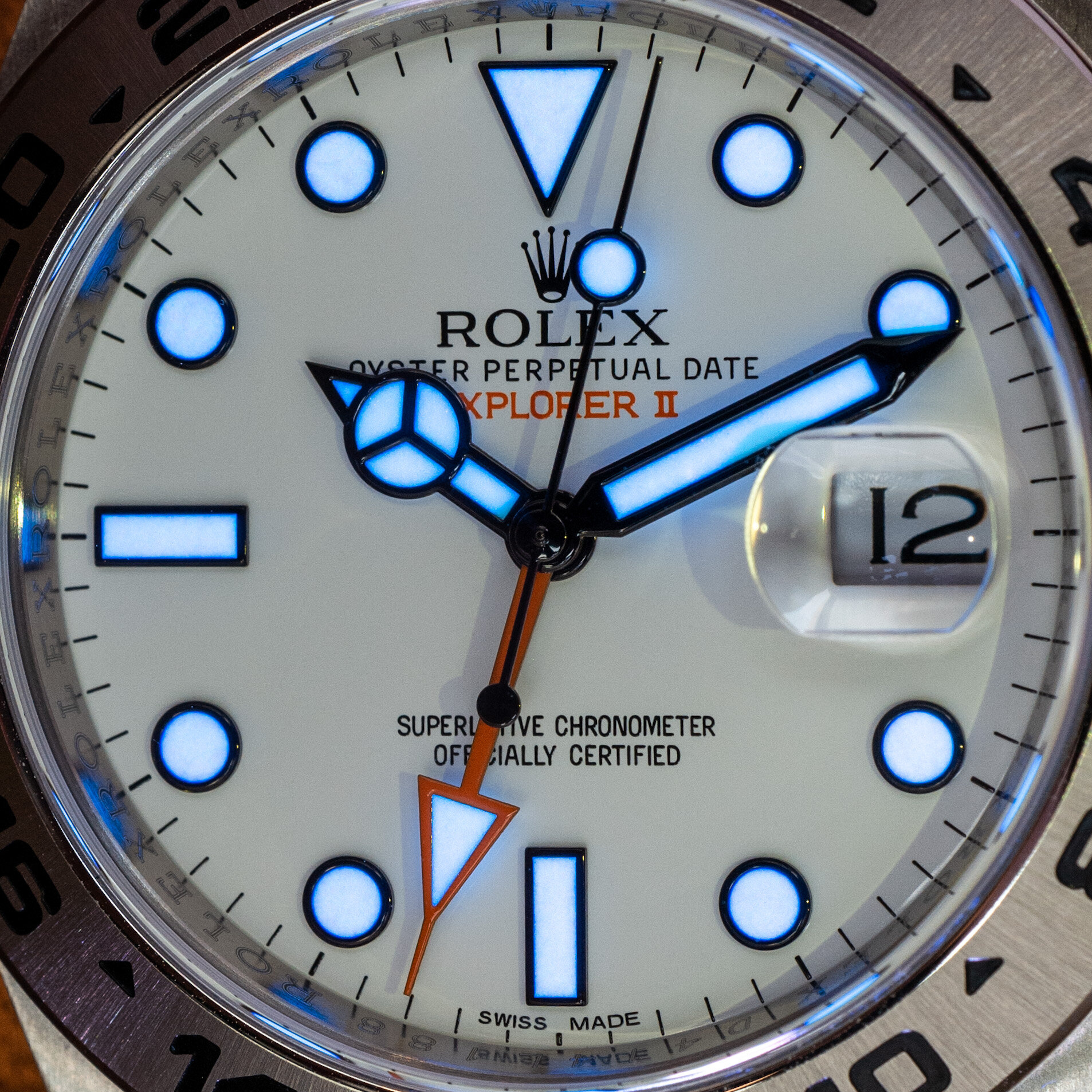
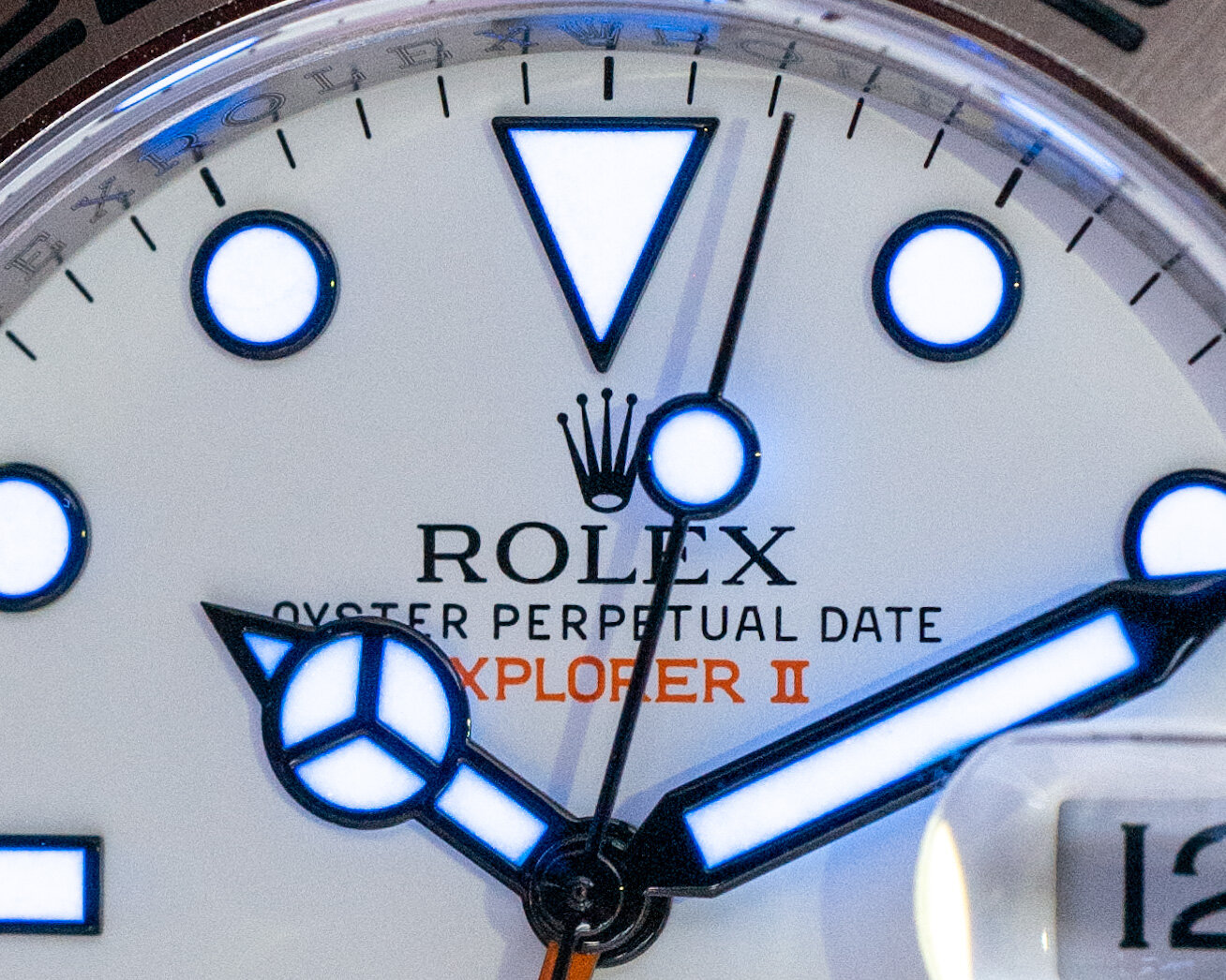
While the dial’s indices have plenty blue Rolex Chromalight applied, there is no application to the bezel nor any special indicator like the 12 hour pearl on the Submariner. Even with what would appear to be a lack of orientation, the twelve hour inverse triangle and clear shape of the GMT hand, make knowing AM and PM a breeze. Remember that the reason for the Explorer II’s existence was to allow the wearer to distinguish night-time to day-time when the watch is worn in a cave. The cyclops, like on the Submariner date model, works well to make the date visible, though I can see many not liking it on first view. In time, it grew on me and now I actually appreciate it.
Bracelet
One of the great joys of wearing a modern Rolex sports watch is the sublime Oyster bracelet that they now use. In my view, the best bracelet in the industry. It’s hard to explain why the Rolex bracelets are above and beyond other steel bracelets, until you try them for yourself and wear them for a while. For me, I noticed how great they were after I added a couple more watches with bracelets in my collection and noticed how terrible these were compared to the Oyster bracelet. I have since switched the majority of my other sports watches to rubber straps.
What makes the Rolex Oyster bracelet so great? For me it’s three key features that I explore in turn. First, the styling of the bracelet is perfect for sports and casual wear. The three links bracelet is not loud, it’s functional, and with a combination of brushed satin finish with slight polish beveling, it creates a sporty and elegant look. Some of the other sports models, particularly the GMT Master II, have center polish links which makes the bracelet look dressier, but for the Explorer II the all satin look is perfect.
Second, is the feel on wrist, which has to do with an even weight distribution and ease of adjustments. It’s the only steel bracelet I have found which tends to stay put when I wear it. Even with a watch as large and relatively heavy as the Explorer II. And it’s not because the bracelet is purely tight fitting, which it is as I like my bracelets, but it’s also because Rolex included a variety of adjustments to perfect the fit (to taste).
Additionally, a brilliant wear-time quick adjustment can be made when our wrists expand during the day. Some of these adjustments have to be decided when you fit the bracelet, for example the screws in the links near the clasp. But it’s also in fine adjustments that Rolex includes in the bracelet clasp itself, which allows close to another 15 mm of setup. Then it’s the EasyLink which provides a quick extra 5 mm adjustment that the wearer can do without even removing the bracelet.
Finally, the Rolex clasp is easy to use, secure, and seemingly indestructible. First, when you lock the clasp you can feel that it is securely set with a satisfying click; and the fold over mechanism provides an added level of security that would normally not be required but ensures that the bracelet won’t wobble and would be virtually impossible to remove unless you use your fingers and / or nails to unhinge it. The addition of the Rolex crown logo on the fold over looks great and is functional to ease your finger and nail to quickly grasp and release the locking hinge.
Variations
As mentioned, the Explorer II reference 216570 is the second large scale update to the first Explorer II reference 16570. The differences between this model and the previous are many but generally can be summarized by the new model’s larger case as well as bringing back the original Explorer II orange arrow hand. And of course, as with any Rolex model update, the new Explorer II includes Rolex’s movement innovations that we discussed previously.
Reference 216570 includes one other variant and it’s the black dial model. I personally much prefer the white dial (or “polar”) reviewed here. The back dial is less contrasty and has an oddity in the hands that people have started naming “ghost hands”. Essentially, the large hour, minutes, and GMT hands are painted in the center in black which make the hands appear to be ghosting from the middle of the dial. Not a problem in the “polar” model since the hands are fully black painted which contrasts perfectly with the white dial.
The other modern Explorer model from Rolex is the continuation of the smaller 39 mm Rolex Explorer, now reference 214270-0003, which is a direct evolution of the model that originally ascended Everest. This is a very different watch from the Explorer II, except in name. I own that watch as well, and in many ways, prefer it more than the Explorer II for its simplicity and direct historical references. But that’s a discussion for another day.
Wearability
From a wearability perspective, the Rolex Explorer II is my least favorite Rolex watch that I own or have owned. On my 6.5 inch wrist, it fits just about right but mostly on the larger side. It’s not too large, it’s simply does not fit as well as the Submariner 114060 nor the smaller 39 mm sports models: the Explorer, the Milgauss, or the Air King. I am convinced that this has to do with the large 42 mm case, 13 mm height, and rather long 50 lug-to-lug and relatively heavy 153 grams on original bracelet with two links removed. Also, it’s not a realization I had when I first got it, I travelled to Asia extensively for two year and took it with me every time. But in time, perhaps my tastes have evolved where I much prefer the fit of the Submariner or better the 39 mm Explorer.
Quirks
Besides the fit and wearability issues I mentioned above, which depends on wrist size and personal preferences, there are three other quirks with this watch worth mentioning. First, the dial layout and bezel. The large indices and large hands with the high contrast glossy black paint make the dial stand out. It’s a great thing if you are looking for a watch that is super easy to read, but for me that also make the Explorer II “polar” stand out from a crowded room. This is perhaps something that many would like, but if you want to be more discreet, it works less well.
The second quirk is minor but a bit annoying once you realize it. And it has to do with the side polish of the case. While the rest of the case and bracelet on the Explorer II uses a beautiful satin finish, the side of the case has a high polish. This has two consequences. First, looking at it on the side, in the sun you get more reflection than otherwise. Not a big deal. The other consequence is more important. And it’s that the side will scratch more than the rest of the watch. I imagine Rolex made this design choice for aesthetic reasons, but I much prefer a full satin brush design, as in the Submariner.
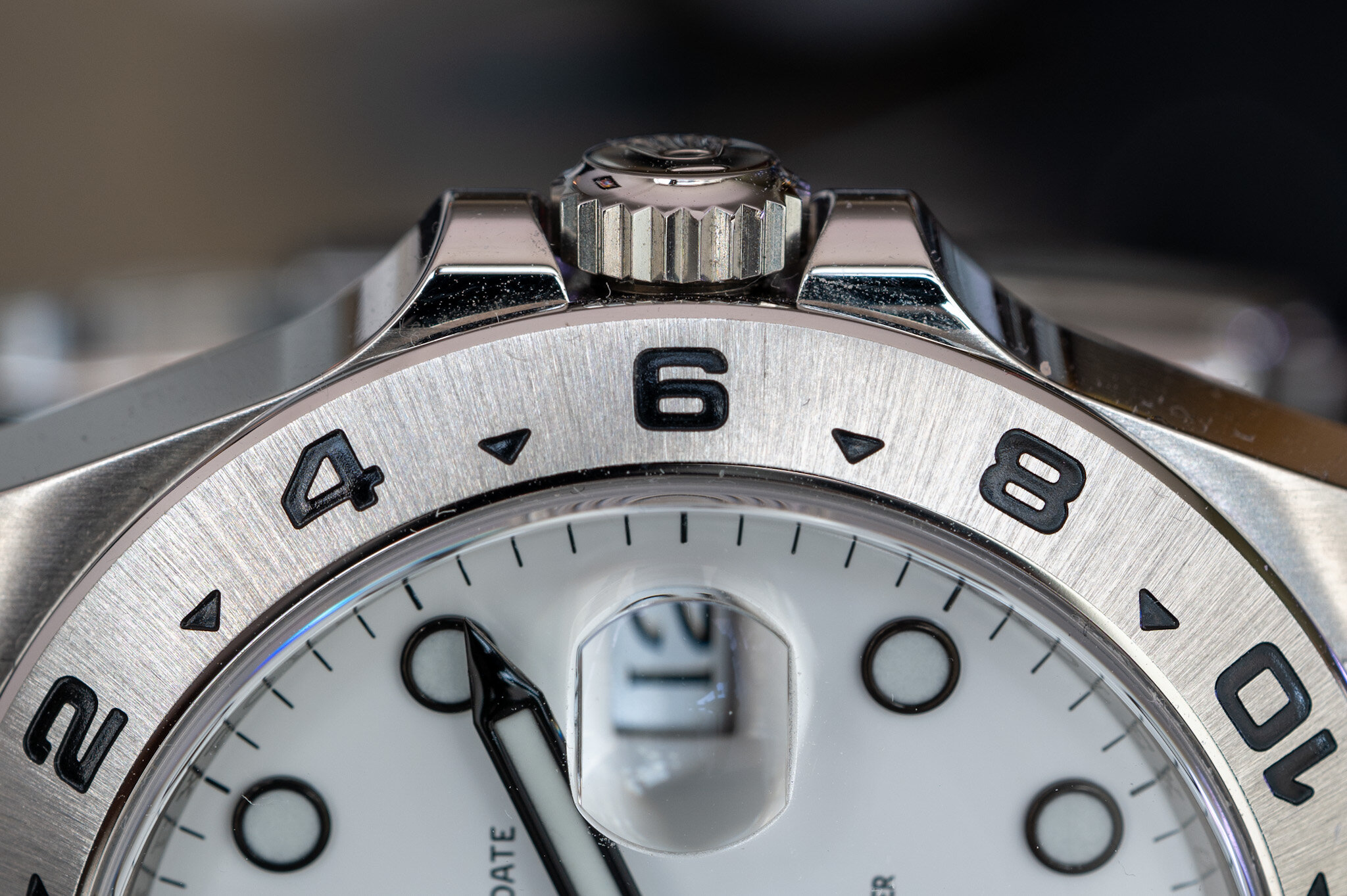
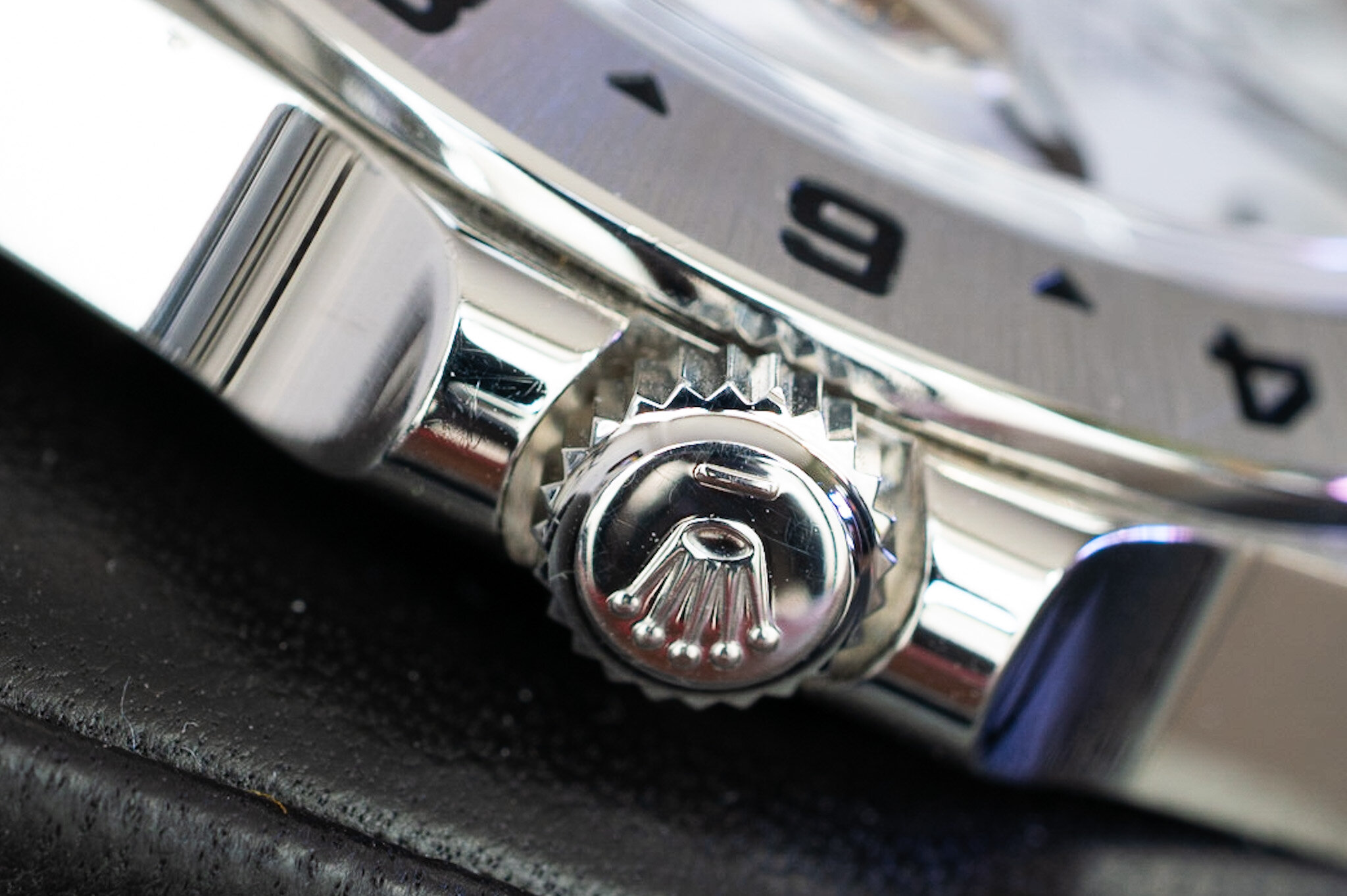
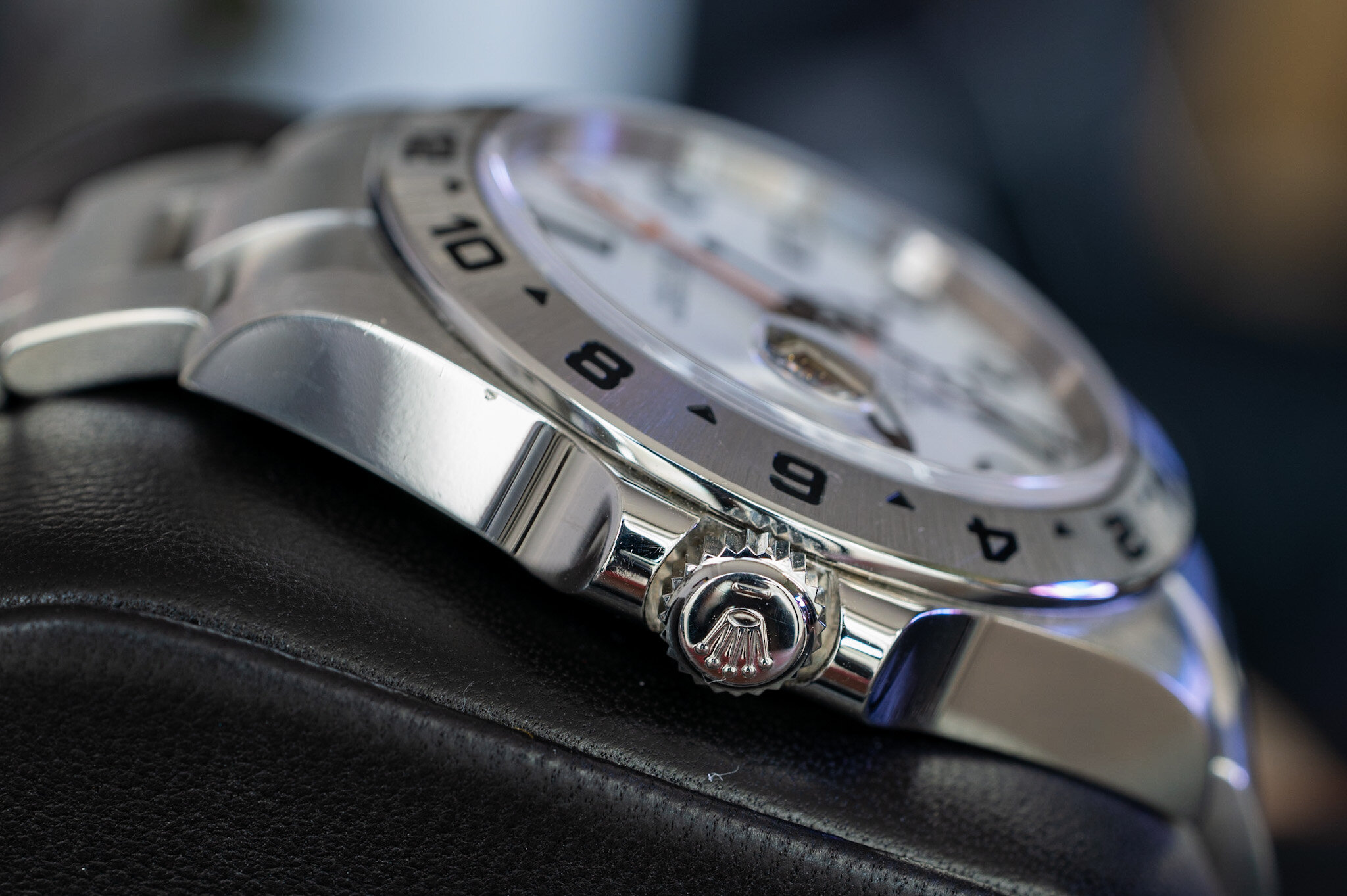
The final quick is minor and perhaps something I obsess about without any reasons. And it’s that I find the crown protectors for the size of the case to be smaller than I would have made them. Unlike the Submariner where the crown protectors are well balanced with the size of the large crown. On the Explorer II which uses a smaller Rolex Twinlock crown, that only has two o-rings gaskets for its 100 meters water resistant, the crown protectors are a bit diminutive. I would have loved to see either the same Submariner larger crown and protector or slightly larger protectors.
Who is it for? Activities
The Rolex Explorer II is a versatile sports watch, so it should be applicable for many watch lovers’ activities. However, I can see two main owners for this watch. First, the guy who wants one Rolex watch that is a bit bigger than the other Rolex sports watches. At 42 mm the Explorer II is much bigger than the 39 mm entry-level sports Rolex and closer to the Submariner and GMT Master II 40 mm wide Oyster case.
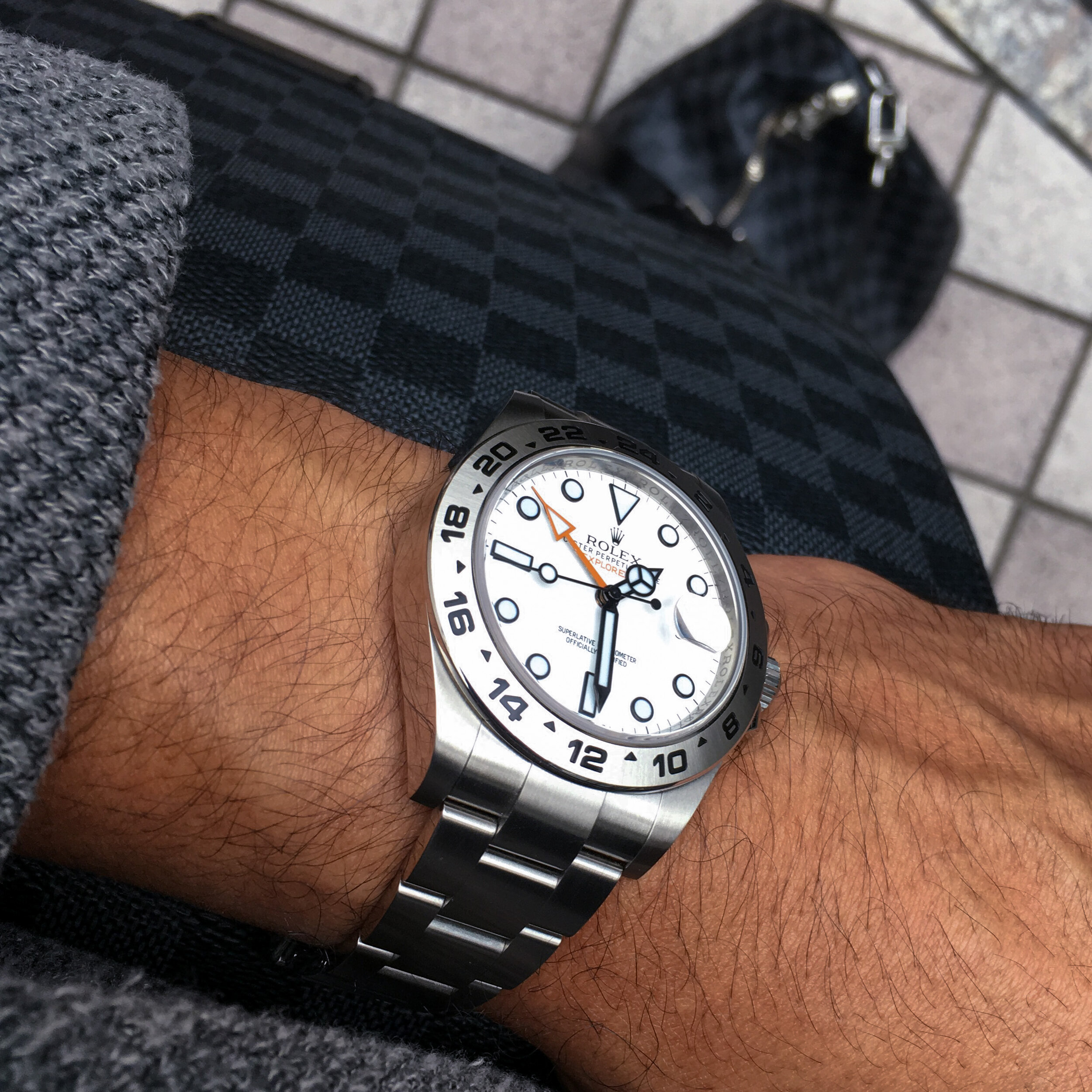
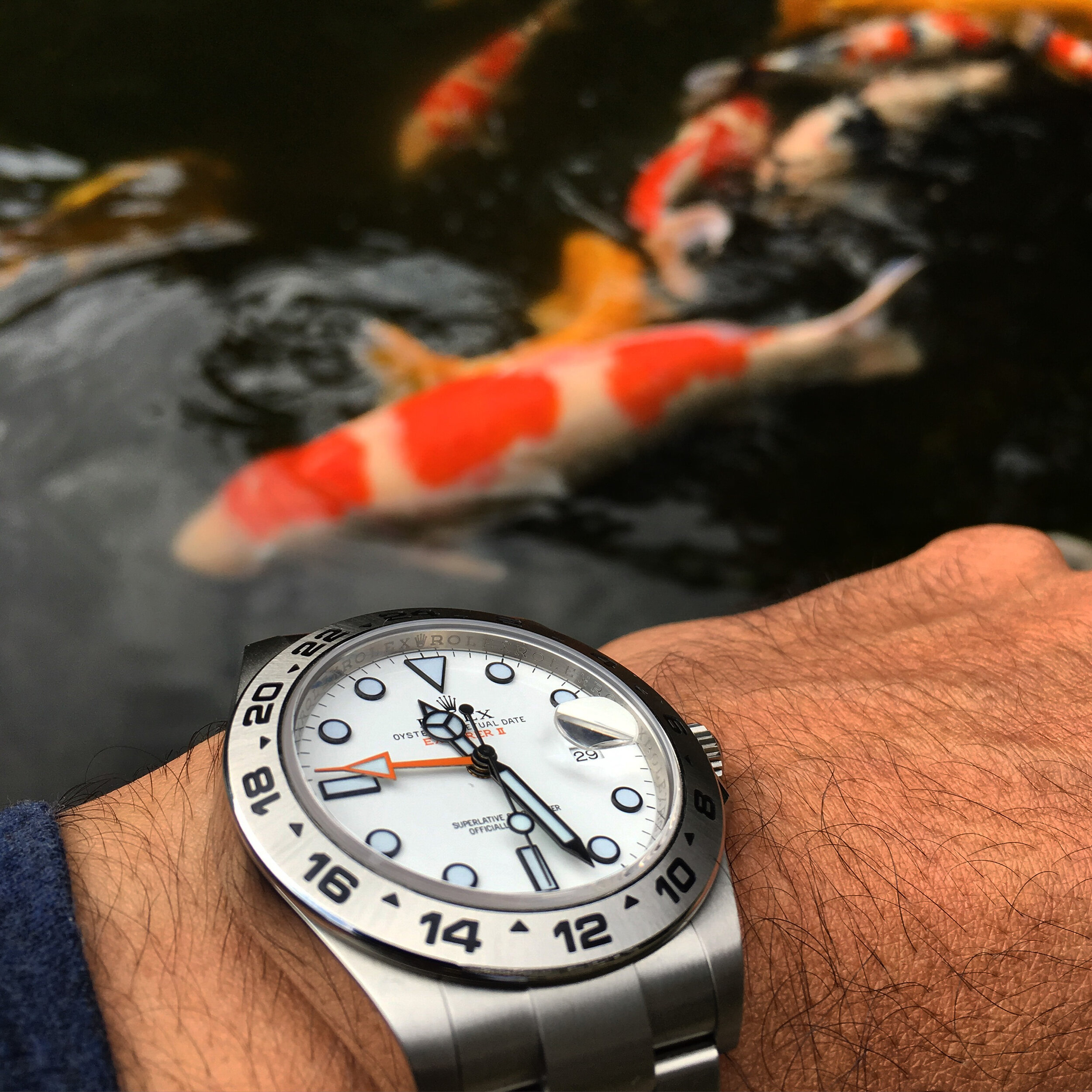


The second buyer is for the guy who already owns other Rolex sports watches but wants one that is quirkier and different. Perhaps I fit best in this category since the Explorer II makes for a good travel Rolex that will not catch too much attention, at least less than a GMT Master II. It’s also, of course, easier to buy than the modern GMT Master II steel models which now have multi-months to multi-years wait lists.
Finally, in terms of what activity this watch is best suited for, for me it’s travel. The GMT second timezone that is super legible makes for the perfect travel watch, with the bright orange GMT hand keeping track of home time. With the in-house 3187 calibre, as I mentioned, this is a watch I took to Asia in multiple occasions, landing in different cities and easily adjusting timezones in a breeze.
During one of my many visits to Beijing, China. Here at the Forbidden City in 2016
Of course, the legible dial and robust construction also make the Explorer II a great all around sports watch used for mountaineering and cave exploration, if that’s a hobby of yours. However, a Garmin Fenix or Casio ProTrek might be a better companion or secondary watch to take with you if you have such extreme hobbies. These electronic watches offer GPS and the slew of features would make these great exploration watches with electronics a backup to your portable phone computer. However, the Explorer II has its place since without the need for secondary power, you can count on it to provide the essential functionality no matter what.
Competition
As a pure GMT tool watch, there are numerous alternatives readily available on the market nowadays offering similar features and of better value. Some even exist from Rolex itself. So before giving some final thoughts on owning and wearing the Explorer II, let me list my top alternatives. Do note that the list is not comprehensive, however, the following are my top choices. I list them mainly because I have experience handling them and have considered them and in one case (Rolex GMT Master II) I have owned one variant for a while in my collection.
Rolex GMT Master II
Perhaps the most direct competitor to the Rolex Explorer II is the Rolex GMT Master II. Also part of the Rolex professional family of watches, the GMT Master II has been part of the Rolex line up since 1980s and was a refreshed model from the original GMT Master which was released in 1954 and targeted at Pan Am pilots, stewardess, and travelers. The main advantage of the GMT Master II versus the Explorer II are twofold. First, the GMT Master II has a rotating bezel. This allows the owner of the watch to easily change the second timezone to a different one.
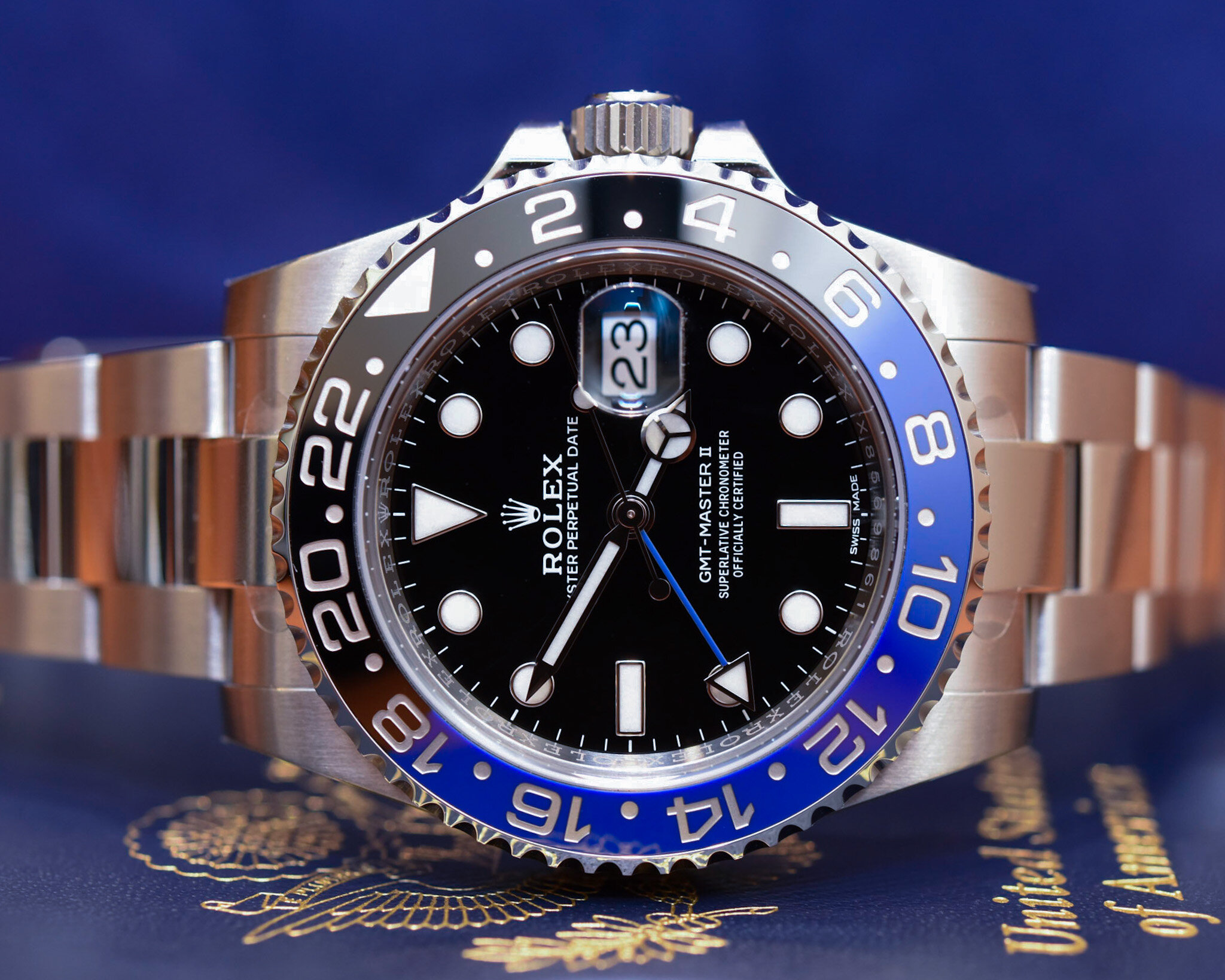
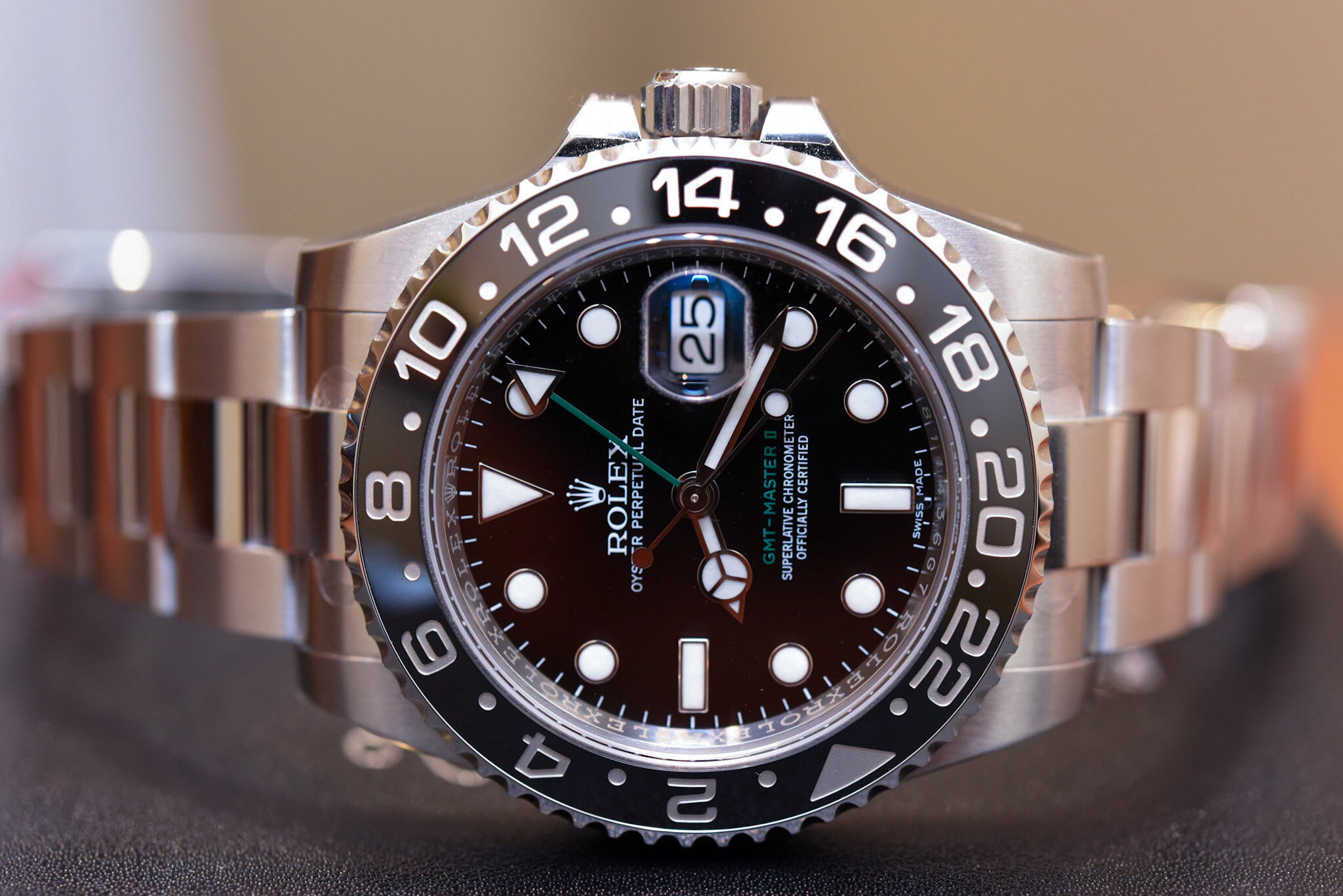
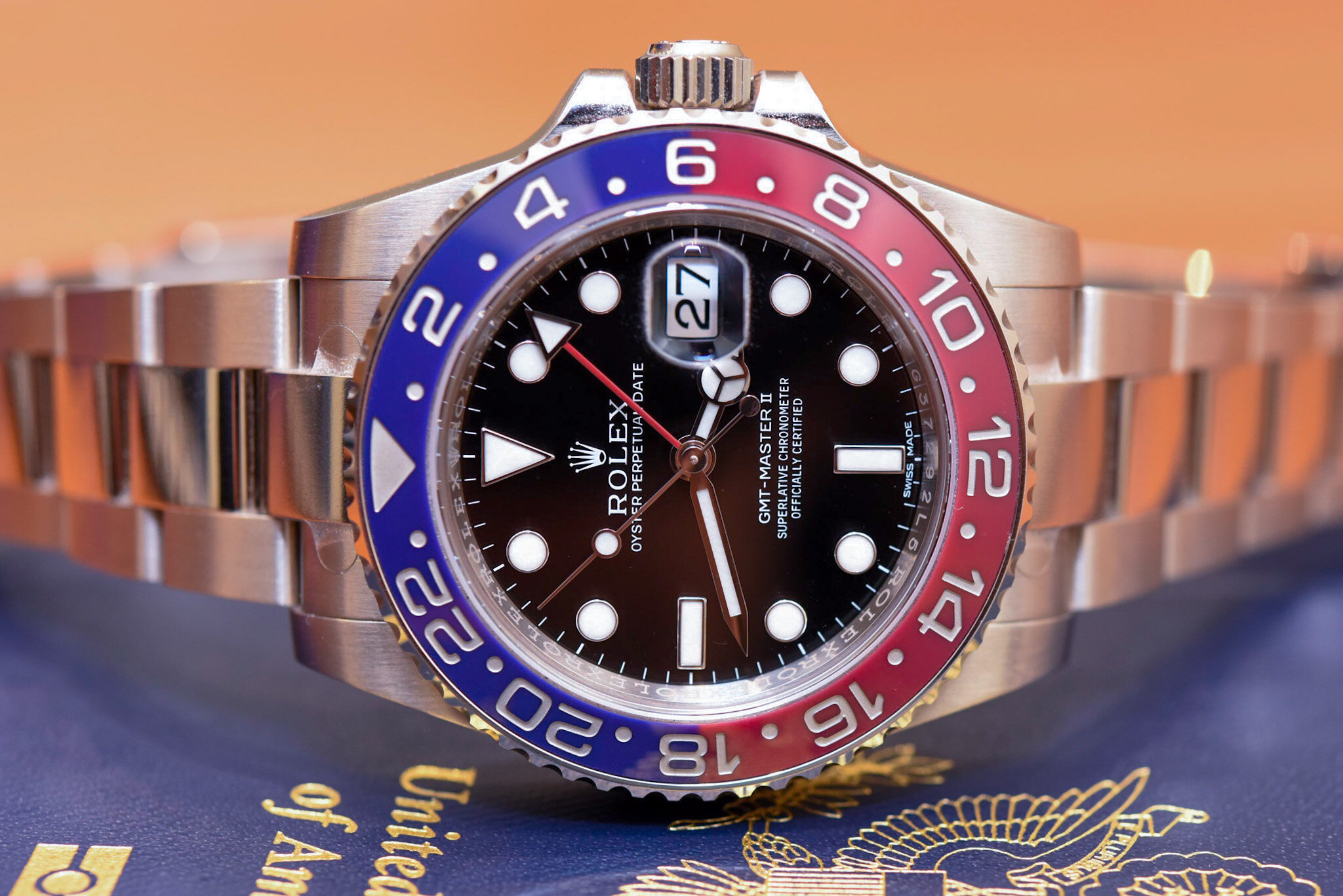
The second advantage with the GMT Master II compared to the Explorer II are stylistic. For example, the case is closer to the one used in the Submariner and was also updated with the wider lugs. However, it remained 40 mm and has similar dimensions as the Submariner. The other stylistic aspect that creates a distinct advantage for the GMT Master II are the different variations that Rolex offers for this model. Not only multiple color variations of the ceramic bezel, a few dial variations, but also different metal options as in the two-tone Rolexor as well as in full white gold, yellow gold, and recently in rose gold.
Rolex GMT Master II ref. 116713LN Rolexor — yellow gold and stainless steel
In my opinion, having own both the Explorer II and the GMT Master II, the latter is the more flexible and desirable model of the two. This sentiment seems widespread as the GMT Master II’s recent release, the blue/red “Pepsi” model is one of the most in demand releases from the brand, second only to the stainless steel ceramic Cosmograph Daytona. However, for me, the main reason I prefer the GMT Master II is the more streamlined dimensions. As I mentioned before, the 40 mm maxi case fits my wrist better than the larger 42 mm of the Explorer II.
Tudor Black Bay GMT
For those interested in a GMT Master II or Explorer II, Rolex, as the parent company, itself offers a very good alternative in the Tudor Black Bay GMT. I was at Baselworld 2018 when this watch was introduced and have seen it again at COTUREtime in Las Vegas. While it’s a solid alternative to the GMT Master II and Tudor lower costs make it an attractive value proposition, I’ve been on the record multiple times with lackluster opinions for Tudor watches. Don’t get me wrong, I think Tudor watches are a good cheaper alternative for their Rolex counterparts, however, unless you are limited financially or just starting in watch collecting, I feel that Tudor watches just do not do it for me, at least compared to a similar Rolex alternative.
The design of the Black Bay GMT is certainly interesting, especially with its unique hands and dial layout. However, unless that design sings to your heart and sensibility, for the price $4,050 USD, a little less than half of the Explorer II ($8,350 USD) and of the GMT Master II ($9,700 USD), my suggestion is to save more and get the GMT Master II. Or better, if you like the original Explorer II, then get that one instead. Of course, this assumes you can get the Rolex models, as they continue to be in demand everywhere and relatively rare at local authorized dealers.
Grand Seiko GMT
One of the watches, not from the Rolex group, that most resemble (in style and purpose) the Explorer II is the Grand Seiko GMT. While not exactly the same, the overall design has similar cues to the Explorer II. Particularly the engraved steel bezel. And with the recent growth of the Grand Seiko brand across the world, this could be a great alternative. And the inner coloration for day and night distinction, as well as the dauphin hands, make this a watch that provides similar values but is different enough to be unique.
That said, this is the not a watch I recommend nor like. Mainly because for me, it lacks gravitas and substance. The Explorer II has a history and long lineage. The Grand Seiko GMT seems like just another GMT watch. I own a Grand Seiko Spring Drive and for me that is the line that I most prefer from the brand. With the GMT, Grand Seiko appears to have simply tried to add a GMT to its stable of watch lines. Clearly you could do worst than the Grand Seiko GMT, however, for the cost of around $6,000 USD my suggestion is to explore the gamut of alternatives and select.
Oris Aquis GMT
The Oris Aquis is primarily the brand’s modern dive watch line. However, Oris has expanded it to also include a GMT complication. As they do for all of their Aquis line, the watch comes well equipped with 300 meters water resistance and options for bracelet, straps (black or blue), and even a leather strap. All options includes Oris’s deployant bracelet with over 15 mm of quick, fine adjustments in the deployant clasp.
For the GMT indication Oris includes an inner circle where a smaller third hand indicates the second timezone. However, Oris goes one farther by also including laser-engraved 24 hours indicators which when rotating the bi-directional bezel, allows the owner to keep track of a third timezone. At $2,700 USD for the most recent model with a beautiful blue dial, this is the best value of all the GMT watches I suggest here.
Final Thoughts
As I mentioned, the Explorer II polar will remain in my permanent collection but will likely not see much wrist time. The large size and relative heavy weight make it the Rolex I don’t love wearing, compared to the others. Especially since my main use for this watch is when traveling. The whimsical look and white dial make up for some of the negatives. While I cannot fault one for getting this watch, it would not be my top recommendation. The GMT Master II is a better travel watch while the initial Explorer is a more classical and timeless everyday watch.
For me, the Explorer II is the watch to get when you are a big guy and the small Rolex sports watches look small on your wrist; or when you’ve acquired all or many of the other Rolex sports watch and this one’s monotone look with orange hints, give it a good reason for entering your collection. Or of course, as was my case when you get to buy a brand new model for a special occasion. And with the knowledge that this watch will surely gain the Rolex wave of appreciation in the years ahead as you pass it down to the next generation. After all, that’s likely the main reason for getting a Rolex you don’t wear regularly... Isn’t it? rolex.com
Editor’s note I want to thank J. LICHT & SONS (previously Davidson & Licht of San Jose) for always allowing me to view their extensive Rolex inventory and often coming through for me when I am ready to add another Rolex model to my small collection. They are the best Rolex authorized dealers in the Bay Area with annual events that give everyone a chance (via raffle) to purchase the latest models. Please call them at (408) 247-1767 or visit their brand new Rolex boutique inside the Westfield Valley mall in Santa Clara, California.
Changes:
04/10/2011 - changed Editor’s note to refer to new name J. LICHT & SONS and a fixed few typo fixes.



